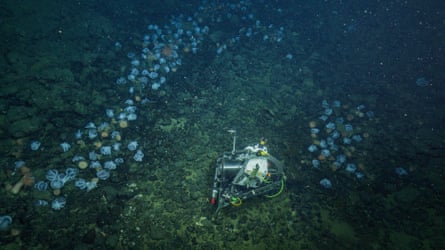
Scientists have solved the mystery of why tens of thousands of octopuses cluster on the foothills of a giant underwater mountain, two miles down off the coast of California. The pearl octopuses, so named because from a distance they look like scattered gems, seek out warm water seeping through the seabed and use it to speed up the hatching of their eggs.
This was the initial hunch scientists had when they discovered the “octopus garden” near Davidson Seamount in 2018, the second of four known deep-sea octopus aggregations.
Returning more than a dozen times with a remotely operated deep-diving robot, a team led by researchers at the Monterey Bay Aquarium Research Institute (MBARI) gathered evidence that backs up this theory and provides astonishing new insights into life in the deep.
The mauve, grapefruit-sized female octopuses each lay about 60 eggs and cement them to the bare rock, then guard them until they hatch. Temperature probes showed the water bathing the eggs ranged from 5C to 10C (40-50F), while less than a metre away it dropped to a frigid 1.6C.
Revisiting individual nests, the team saw that rather than taking a decade or longer to hatch, as would happen in the very cold deep sea, baby octopuses emerge from their cosy nests after less than two years, dramatically boosting their chances of survival.

The warm water comes from hydrothermal springs, which are not as scorching as hydrothermal vents, also known as black smokers. “It never gets super-hot [enough] to cook the eggs of an octopus,” says Dr Jim Barry, from MBARI, who led the study.
Based on photographs covering a small portion of the site, Barry and colleagues estimate the entire 333-hectare (823-acre) garden contains more than 20,000 octopuses, the largest aggregation scientists have found.
Time-lapse cameras left among the nests tracked the molluscs’ comings and goings. “Instead of this horde of octopuses, they turned into a bunch of individuals,” says Barry.
What is the Discovered in the deep series?
ShowThe ocean is one of the world’s last truly wild spaces. It teems with fascinating species that sometimes seems to border on the absurd, from fish that look up through transparent heads to golden snails with iron armour. We know more about deep space than deep oceans, and science is only beginning to scratch the surface of the rich variety of life in the depths.
As mining companies push to industrialise the sea floor and global leaders continue to squabble over how to protect the high seas, the Guardian's Seascape series, Discovered in the deep, will profile some of the most recently discovered weird, wonderful, majestic, ridiculous, hardcore and mind-blowing creatures. They reveal how much there is still to learn about the least known environment on Earth – and how much there is to protect.
All through the year, new adult females and males arrived. They were never seen feeding and were never joined by smaller octopuses, indicating that the site is used exclusively for mating and nesting.
As with most octopuses, male pearl octopus die shortly after mating, while females try to hang on until their eggs hatch. Barry describes seeing sea anemones chewing on octopus carcasses.
These and other scavengers – including fish, shrimp, sea stars and snails – form a thriving ecosystem sustained by the dead octopuses. A short way off, in similar areas of rocky seabed, animal life is far less dense.
Mysteries remain, including how far the octopuses migrate to the nest sites and whether, like salmon, they return to the spot where they were born. Octopuses have a good sense of smell and may follow the scent plume drifting from so many of their dead relatives.
Barry expects there are more deep-sea octopus nurseries to discover. But while this octopus garden is protected within the Monterey Bay national marine sanctuary, other sites may be vulnerable to trawling and deep-sea mining.
“It’s important that we consider the value of these little spots, and not indiscriminately wipe out areas of seabed,” he says.










 English (US)
English (US)